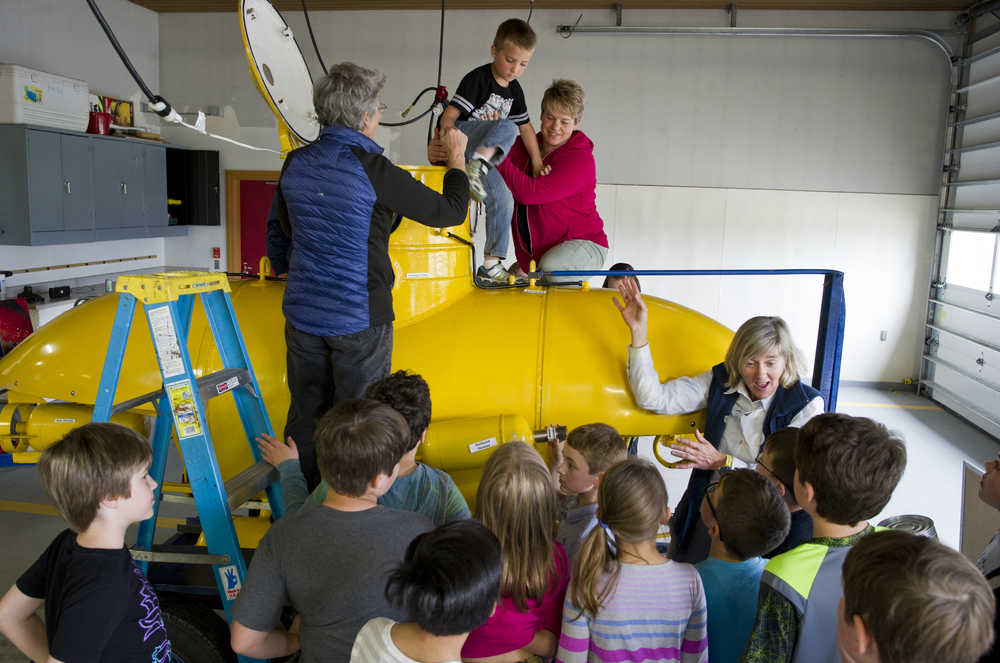Before lowering himself into Aureo, an erstwhile research vessel brought to Juneau to teach kids about ocean sciences, local Faith Community Christian School fourth-grader Lucas Thompson — who aims to be a pro football player — wasn’t too keen on the sea.
“I don’t think I want to have anything to do with the ocean, unless the ocean has to do with football,” Thompson said.
But after checking out the 14-foot yellow submarine, Thompson changed his tune.
“Now it’s very hard to decide, very hard,” he said about his career choice.
Juneau elementary and middle school students have been exploring the sub with local marine ecologist Michelle Ridgway this week, learning about ocean sciences and the where their Science, Technology, Engineering and Math (STEM) courses can take them.
Heidi Boucher’s third- and fourth-grade class jostled in line to board the single-person submersible, which was hauled on its trailer to the Auke Bay Fire Station Tuesday for the field trip. Students held pictures of octopi and sharks in front of the viewport to simulate a mission.
Words like “cool,” “awesome” and “epic” were thrown about.
“I’m just really interested in all those creatures,” fourth-grader Joshua File said. “I want to be an ocean explorer and see all the cool stuff down there.”
Ridgway has worked as an ecologist everywhere from Metlakatla to Barrow to the Aleutian-Pribilof Islands and uses submersibles to study deep sea food webs.
Ridgway, who has worked in all kinds of ocean habitats, said nothing beats teaching kids ocean sciences than with hands-on experiences. They always respond positively, she said.
“It’s not just my opinion, I’ve observed this and data supports it,” Ridgway said. “I’ve trained kids with ROVs (Remote Operated Vehicles) and it’s very validating to them to see what’s possible with real tools and tactile context. I am not a teacher, so I treat them like a research partner.”
Ridgway’s found the hands-on approach helps answer the one question all students ask: “When am I ever going to use this?”
“I’ve heard from principals and teachers that they pay much closer attention in math and science courses when they know they’re going to apply it,” Ridgway said. “Students still talk about these experiences, some have gone on in careers in this, and I hear from them from time to time in emails.”
The Alaska chapter of the Explorers Club and the Alaska Deep Sea Ocean Sciences Institute partnered to make the sub available to kids. Ridgway is the chair of the Alaska chapter of the Explorers Club and helped put together a deal with a partial donation and partial purchase of the vessel from Kodiak resident Dick Waddell. The Aureo sailed from Kodiak to Juneau on the M/V Kennicott this spring.
The Aureo is still a fully-functioning sub, though it’s been simplified so kids can use it safely and will not damage it. It’s designed to dive 120 meters and is powered by two four-foot long battery pods and three thrusters, one each on the port (left) and starboard (right) and one main thruster on the stern (back). High pressure tanks on Aureo’s sides allow it to release pressure as it sinks below the waves.
Ridgway wants to see Alaskans take ownership of science and technology, and believes her volunteer work with kids can help spur the next generation to accept that challenge.
“Personally, I want to see Alaskans develop our own technology to research our massive undersea region for resources, sea life biodiversity, marine pharmaceuticals, archaeology, detecting change in the ocean,” Ridgway said. “Currently, we largely rely on technology developed for environments elsewhere, often transported at tremendous cost, and often operated by outside entities. I believe our maritime heritage, science savvy and intimate reliance on the ocean are ideal Alaskan attributes to marshal for developing science and technology jobs to advance research under Alaskan seas.”
Ridgway also brought an ROV with her to share with the students. “Ruby,” is 3 feet long and is operated remotely by a controller, which one student was intrigued by because it was “just like Xbox.”
Though the kids were universally astounded by their experience, it wasn’t lost on them that working in a single-person submersible is no life of ease in a sea of green.
“I thought there was going to be more space,” Jenna Sydney, a student in Trista Anderson’s first- and second-grade class, said.
“You have to pee in a bottle,” classmate Taylor Williams added, “What do you do with it, throw it in the trash?”
• Contact Outdoors reporter and Sports Editor Kevin Gullufsen at 523-2228 or at kevin.gullufsen@juneauempire.com.

